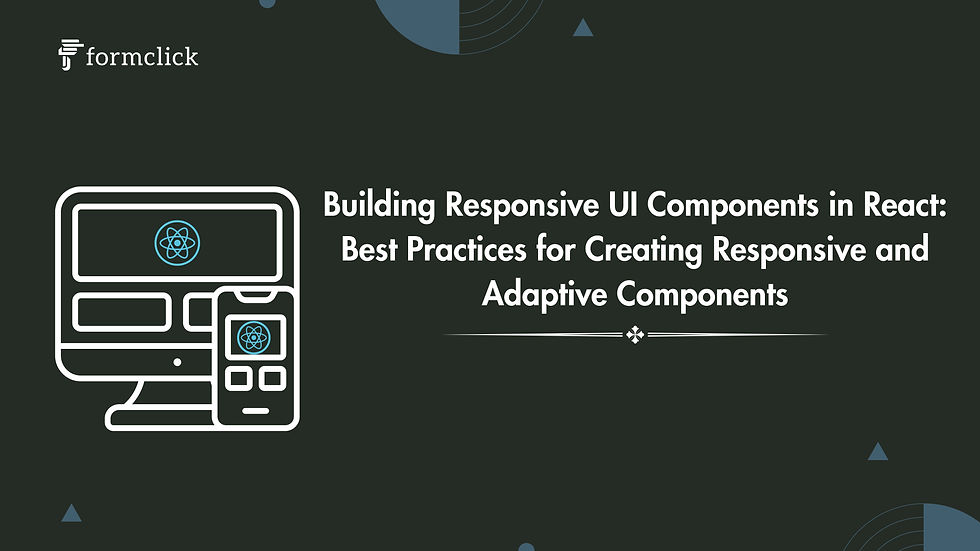
In today’s world, users access websites and applications from a variety of devices, including desktops, tablets, and smartphones. Ensuring that your React applications look and perform well on all these devices is crucial. In this blog post, we’ll explore best practices for building responsive UI components in React, along with practical examples.
What is Responsive Design?
Responsive design is an approach to web development where the layout and elements of a website adapt to the screen size and orientation of the device being used. This ensures a consistent and optimal user experience across different devices.
Best Practices for Creating Responsive Components
1. Use CSS Flexbox and Grid
CSS Flexbox and Grid are powerful tools for creating responsive layouts. Flexbox is ideal for one-dimensional layouts (either row or column), while Grid is better suited for two-dimensional layouts (rows and columns).
Example: Flexbox
import React from 'react';
import './App.css';
const App = () => {
return (
<div className="container">
<div className="item">Item 1</div>
<div className="item">Item 2</div>
<div className="item">Item 3</div>
</div>
);
};
export default App;
/* App.css */
.container {
display: flex;
flex-wrap: wrap;
justify-content: space-around;
}
.item {
flex: 1 1 200px;
margin: 10px;
background-color: lightblue;
padding: 20px;
text-align: center;
}
Example: Grid
import React from 'react';
import './App.css';
const App = () => {
return (
<div className="grid-container">
<div className="grid-item">Item 1</div>
<div className="grid-item">Item 2</div>
<div className="grid-item">Item 3</div>
<div className="grid-item">Item 4</div>
</div>
);
};
export default App;
/* App.css */
.grid-container {
display: grid;
grid-template-columns: repeat(auto-fit, minmax(200px, 1fr));
gap: 10px;
}
.grid-item {
background-color: lightcoral;
padding: 20px;
text-align: center;
}
2. Media Queries
Media queries are a cornerstone of responsive design, allowing you to apply different styles based on the device’s characteristics, such as width and height.
/* App.css */
.container {
display: flex;
flex-wrap: wrap;
justify-content: space-around;
}
.item {
flex: 1 1 200px;
margin: 10px;
background-color: lightblue;
padding: 20px;
text-align: center;
}
@media (max-width: 600px) {
.item {
flex: 1 1 100%;
}
}
3. Responsive Units
Using responsive units such as percentages, vw (viewport width), vh (viewport height), and rem can help ensure that your components adapt to different screen sizes.
/* App.css */
.container {
display: flex;
flex-wrap: wrap;
justify-content: space-around;
}
.item {
flex: 1 1 calc(100% - 40px);
margin: 10px;
background-color: lightblue;
padding: 2rem;
text-align: center;
}
@media (min-width: 600px) {
.item {
flex: 1 1 calc(50% - 40px);
}
}
@media (min-width: 900px) {
.item {
flex: 1 1 calc(33.333% - 40px);
}
}
4. Using React Hooks for Responsive Design
React hooks such as useEffect and useState can be used to create responsive components that adapt based on the window size.
import React, { useState, useEffect } from 'react';
import './App.css';
const App = () => {
const [windowWidth, setWindowWidth] = useState(window.innerWidth);
useEffect(() => {
const handleResize = () => {
setWindowWidth(window.innerWidth);
};
window.addEventListener('resize', handleResize);
return () => window.removeEventListener('resize', handleResize);
}, []);
return (
<div className="container">
<div className="item">{windowWidth >= 600 ? 'Desktop View' : 'Mobile View'}</div>
</div>
);
};
export default App;
5. Mobile-First Design
Adopting a mobile-first approach means designing for smaller screens first and then progressively enhancing the design for larger screens.
/* App.css */
.container {
display: flex;
flex-direction: column;
}
.item {
background-color: lightblue;
padding: 20px;
margin: 10px 0;
text-align: center;
}
@media (min-width: 600px) {
.container {
flex-direction: row;
}
.item {
flex: 1;
margin: 10px;
}
}
6. Utility Libraries
Consider using utility libraries such as Tailwind CSS or styled-components to simplify and streamline your responsive design process.
Example: Tailwind CSS
import React from 'react';
import 'tailwindcss/tailwind.css';
const App = () => {
return (
<div className="flex flex-wrap justify-around">
<div className="flex-1 m-2 p-4 bg-blue-200 text-center">Item 1</div>
<div className="flex-1 m-2 p-4 bg-blue-200 text-center">Item 2</div>
<div className="flex-1 m-2 p-4 bg-blue-200 text-center">Item 3</div>
</div>
);
};
export default App;
Example: Styled-Components
import React from 'react';
import styled from 'styled-components';
const Container = styled.div`
display: flex;
flex-wrap: wrap;
justify-content: space-around;
`;
const Item = styled.div`
flex: 1 1 200px;
margin: 10px;
background-color: lightblue;
padding: 20px;
text-align: center;
@media (max-width: 600px) {
flex: 1 1 100%;
}
`;
const App = () => {
return (
<Container>
<Item>Item 1</Item>
<Item>Item 2</Item>
<Item>Item 3</Item>
</Container>
);
};
export default App;
Conclusion
Building responsive UI components in React involves using a combination of CSS techniques, responsive units, media queries, and React hooks. By following best practices and utilizing modern tools and libraries, you can create adaptable and user-friendly interfaces that provide a seamless experience across all devices.
Remember to test your components on various screen sizes and devices to ensure they perform as expected. With these strategies in hand, you’re well on your way to mastering responsive design in React.

Comments